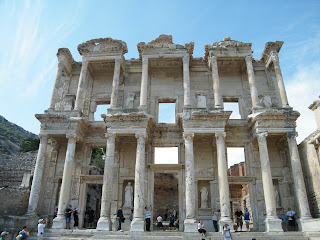A
Divided Country?
Mutlu yılbaşı! Happy New Year! I hope this entry finds all of you well! Recently I haven’t been able to consistently write about my experiences but one of my New Year resolutions is to write more frequently.
The last few months I haven’t been able to travel too much yet I was able to witness the celebration of the eighty-ninth anniversary of the Turkish Republic or, rather, lack thereof. Until a few years ago, national elites, cities and schools would arrange parades and speeches to commemorate not solely the birth of the Turkish Republic but also its founding father, Atatürk. This October 23rd many people in our neighborhood and around the country proudly hung Turkish flags outside of their apartments and businesses yet unlike previous years, local officials did not organize any specific parade or fireworks.
What I found very interesting is that some believe public celebrations in some Turkish cities were strongly discouraged. One incident that gained national coverage occurred in Ankara at Anıtkabir, the Mausoleum and museum of Atatürk, where protesters clashed with police after a parade and march to the famous site were forbidden. Though these images were broadcasted over the web, it looks like international press and public opinion barely noticed. You might ask, “Why should public opinion have paid attention to some young people’s desire to march to Ataturk’s tomb? Well, what I could understand speaking with some Turkish friends is that these people were not what in soccer would be called “hooligans” of Atatürk; rather, they were strong believers in the Republican values which, they believed are being threatened by the current government.
In his book “The Turks Today”, Andrew Mango points out that nowadays, the new political elite strongly encourage young students to attend theological faculties in an attempt to undermine possible social changes triggered by the country’s rapid modernization. Similarly, governmental attitudes toward the Republic’s Day and its celebrations vividly highlight the strength of furtive contradictions between progressive and conservative fringes of Turkish society. It provides another interesting example of political and cultural fragmentation throughout the nation.
I would argue that competing religious and secular values produce divisive feelings toward Republican ideals that relate to the process of secularization. In this regard, current Turkish society somehow resembles the nineteenth century European experience and its complex path to nation-state building. This factor, however, is not the single element of disunity that exists in Turkish society.
I recently began a very interesting book on Kurdish nationalism and while reading I try to some interesting parallels with my study on Trieste, a case whose differences far surpass its similarities. The problem of Kurdish separatism is often mentioned within international public opinion. As recently highlighted in a very interesting articles within the pages of The Economist, this problem is inextricably intertwined with other sensible economic and political issues, among them oil and foreign Turkish diplomacy with Syria, Iraq, and the American government.
This issue deserves a very accurate, detailed, and scholarly examination. An historian of Kurdish nationalism or an expert in Turkish history would be the most qualified person to carry out such analysis. So, here I would just make a few points based upon my understanding of traditional socio-political dynamics in border regions and some impressions that I have formulated after talking with some Turkish friends who are much more familiar with the topic.
Every week, the news tells of injuries, kidnappings and deaths of state officers or soldiers in southeastern provinces of the country. These incidents are often depicted as a clear example of the PKK’s aggressive strategy to reassert its independent and separationist goals yet despite popular stereotypes of the region and its residents; it appears that the low intensity warfare only regards a tiny segment of the Kurdish community. In Malatya, for example, a city populated both by Turks and Kurds, such hostility and antagonism is hardly perceived; otherwise, Kurds as well as other ethnic minorities have lived together for centuries, many times sharing the same traditions, religion, and enjoying the same cuisine.
It seems that one of the main issues at stake is the use of language. Kurds’ claim for the use of Kurdish language in public space is commonly perceived as a first step toward territorial separation. Statements like these, however, are very problematic. For example, the post-war case of the Slovene minority in the Italian city of Trieste has shown that, among other factors, some forms of protection of linguistic and cultural minority rights undermined rather than strengthened the perspective of territorial separation. In the long-term such a strategy has decisively eased the tensions between competing ethnic groups and promoted the democratic maturation of the society as a whole, despite some moments of strong antagonism. The firm defense of state territorial unity combined with the protection of specific linguistic, cultural, religious practices, and the concessions of forms of administrative autonomy. These policies weakened violent confrontation and fostered political dialogue.
In addition, being that the armed struggle is carried out by small groups who profit from political propaganda and indoctrination on poor segments of their communities, economic and educational reforms could potentially strengthen perspectives of peace. This might eventually allow Turkey to finally end its notoriously unpopular and controversial compulsory military service, which the majority of Turks cannot avoid and is partially justified by this ongoing problem.
Although two issues represent elements of division, there is another side of the coin that needs to be taken into account. Turkish society and its traditional cultural, ethnic, and religious diversity can be best understood by travelling. To explore this dimension, last month I visited Antakya, a wonderful city near the Syrian border. This city, which is rich in both culture and history, offers interesting insight on the issues discussed so far. In the next entry I will tell you a little bit more about this beautiful Mediterranean city. Don’t miss it!
















.JPG)
.JPG)


